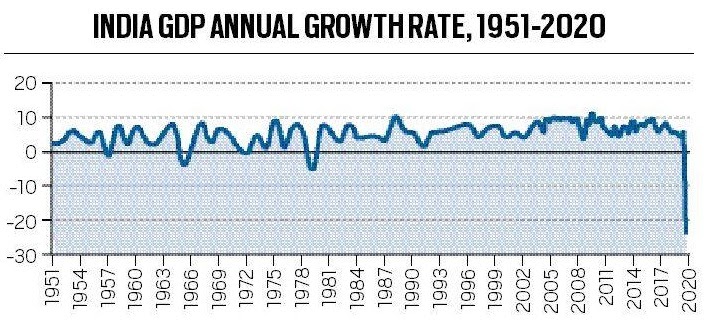Technical Recession
What’s in the news?
- A ‘nowcast’ (a forecast that estimates the outcome of a near-term event) in the latest monthly bulletin of the RBI projected that India’s GDP contracted by 8.6% in the July-September quarter of the financial year ending in March 2021.
- According to the bulletin, India has entered a technical recession in the first half of 2020-21 for the first time in its history with the second quarter of the current financial year likely to record the second successive quarter of GDP contraction.
- GDP had shrunk by 23.9% in the first quarter.
- To better understand the term “technical recession”, one must distinguish it from two other phrases — a recession and a recessionary phase of an economy.
What is a recessionary phase?
- When the overall output of goods and services — typically measured by the GDP — increases from one quarter (or month) to another, the economy is said to be in an expansionary phase. And when the GDP contracts from one quarter to another, the economy is said to be in a recessionary phase.
- Together, these two phases create what is called a “business cycle” in any economy. A full business cycle could last anywhere between one year and a decade.

- The above line graph maps India’s quarterly real GDP growth since 1951. The peaks and troughs show the different expansionary and recessionary phases of the economy. As the graph shows, there have been several expansionary and recessionary phases in India’s history.
How is a recession different?
- When a recessionary phase sustains for long enough, it is called a recession. In other words, when the GDP contracts for a long enough period, the economy is said to be in a recession.
- There is, however, no universally accepted definition of a recession — as in, for how long should the GDP contract before an economy is said to be in a recession. But most economists agree with the definition that the National Bureau of Economic Research (NBER) in the United States uses.
- According to NBER, “During a recession, a significant decline in economic activity spreads across the economy and can last from a few months to more than a year”.
- NBER typically looks at various variables — employment, consumption etc — apart from GDP growth to arrive at a decision. It also looks at the “depth, diffusion, and duration” of decline in economic activity to determine whether an economy is in a recession or not.
What is a technical recession?
- A technical recession is a term used to describe two consecutive quarters of decline in output. In the case of a nation’s economy, the term usually refers to back-to-back contractions in real GDP.
- The most significant difference between a ‘technical recession’ and a ‘recession’ is that while the former term is mainly used to capture the trend in GDP, the latter expression encompasses an appreciably more broad-based decline in economic activity that covers several economic variables including employment, household and corporate incomes and sales at businesses.
- Another key feature of a technical recession is that it is most often caused by a one-off event (in this case, the COVID-19 pandemic and the lockdowns imposed to combat it) and is generally shorter in duration.
How long do recessions last?
- Typically, recessions last for a few quarters. If they continue for years, they are referred to as “depressions”. But a depression is quite rare; the last one was during the 1930s in the US.
- In the current scenario, the key determinant for any economy to come out of recession is to control the spread of Covid-19.
- In India’s case, Finance Minister Nirmala Sitharaman has expressed hope that India’s recession could be already over and that the economy may register positive growth in the current quarter.
References:
Subscribe
Login
0 Comments
